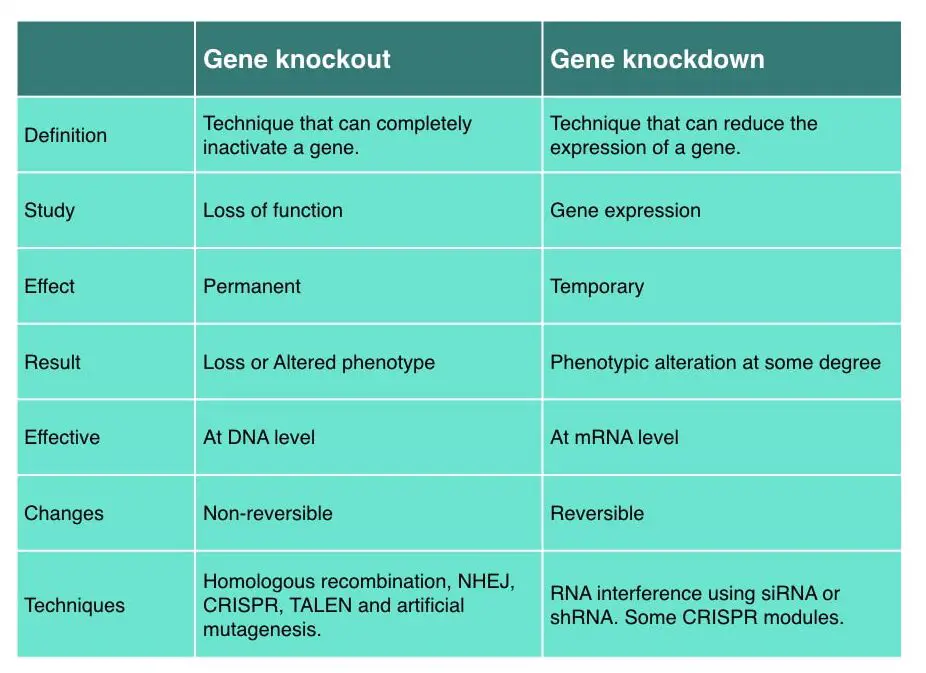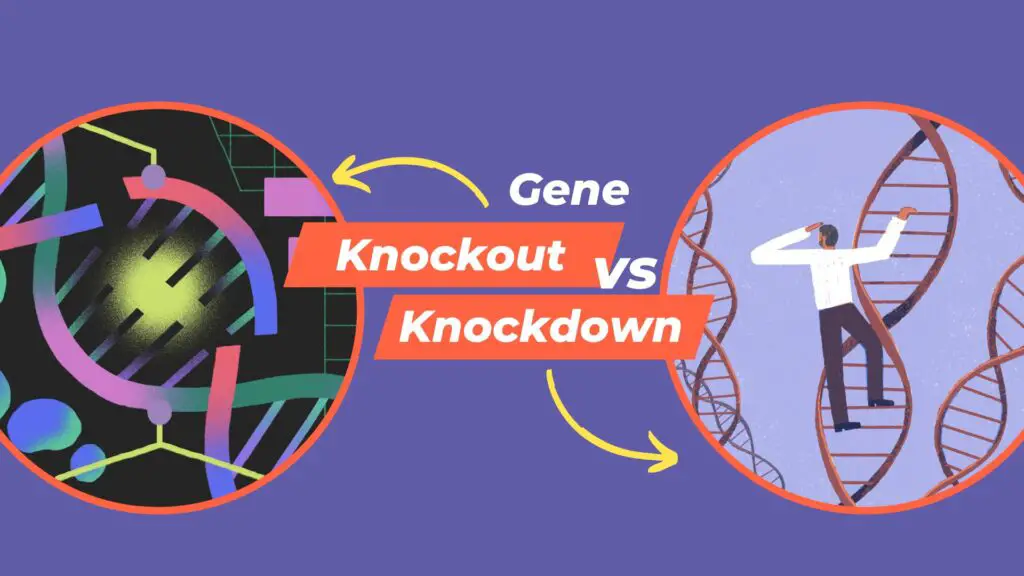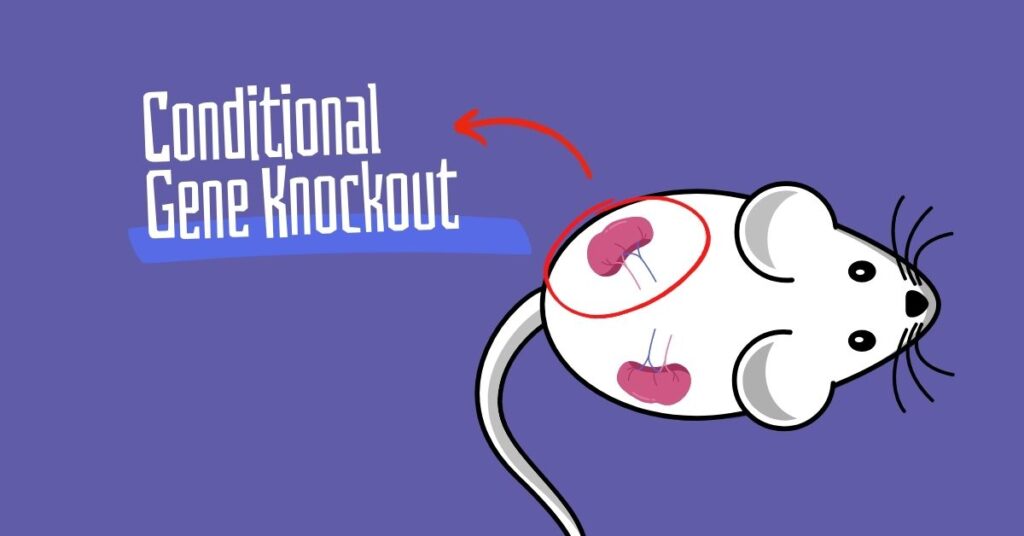“Understand the concept of two common genetic manipulation techniques- gene knockout and gene knockdown. Explore the differences and similarities between both, in this article.”
Genes make proteins, the only functional part of our genome. Thus, the study of genes enables researchers to understand the functional dynamics of our genome. Gene manipulation is a powerful technique developed by scientists to conduct functional genomic analysis.
Gene knockout and gene knockdown are two popular and important gene manipulation techniques. In genetic research, scientists employed these techniques to understand the function and effect of specific genes.
Although both techniques are gene manipulation tools, they differ significantly in their approach, applications and outcomes. This article shed light on the understanding of gene knockout and knockdown, and some of the differences and similarities.

Key Topics:
What is gene knockout?
Gene knockout is a genetic engineering process in which a gene is deactivated using artificial techniques or mutagenesis. Capecci et al. (1980) are pioneers in gene knockout technology and the team was awarded the Nobel Prize for Physiology and Medicine in 2007.
A gene knockout from the organism is known as a gene knockout organism. Applications of gene knockout are functional genomic studies (gene function), genotype-phenotype correlation, evolutionary studies, livestock improvement, agriculture and disease studies.
Notwithstanding, gene knockout is a complex, laborious and less accurate technique. And knockout for some vital genes can not be performed. In addition to this, off-targeting is also a limitation of KO.
What is Gene knockdown?
Gene knockdown is a technique to reduce the expression of a target gene through artificial mutagenesis, chemical modifications and DNA primary and secondary structure alterations.
Knockdown may help to study the effect of gene expression on the governing phenotype. However, it can not study the complete effect of gene loss. Vital genes’ expression can be knocked down to some extent to understand its lethal consequences.
Notwithstanding, gene knockdown produces temporary changes that can be reversed as well.
Similarities between gene knockout vs knockdown:
Gene knockout and knockdown are the techniques of gene manipulation. And are used to alter a gene’s structure and thereby gene expression. Thus, it modifies or alters gene expression, gene activity and phenotype.
However, note that the phenotypic alteration by gene knockdown depends on the amount of mRNA suppression.
Both techniques are used to study gene function, understand their role in diseases and help in developing therapeutic applications. Gene knockout and knockdown are also utilized in drug discovery and studies.
One of the important applications of both techniques is in comparative studies. They can be used to determine the effect of complete versus partial gene expression loss. Such studies can help to understand how important a gene and its function is!
Related article: A Brief Introduction to “Gene Mapping”
Differences between gene knockout vs knockdown:
As per the Oxford Language dictionary, the meaning of knockout is ‘complete elimination’, which means complete elimination of a gene. Whereas the meaning of knockdown is ‘reduce at some level’, which means a reduction in gene expression.
Gene knockout is also known as complete gene inactivation. It eliminates a gene function completely by targeted inactivation. Whereas gene knockdown can not completely deactivate a gene but rather reduces gene expression.
Consequently, gene knockout can completely alter or vanish the phenotype or trait governed by the target gene. On the other hand, gene knockdown reduces or alters the phenotype or trait to some extent.
Meaning, gene knockdown reduces the activity to varying degrees but not completely. Such studies help understand the impact of different gene expression levels on phenotypes.
So the resulting effect of gene knockout is noticeable and clear whereas gene knockdown may cause mild to moderate or extreme noticeable and clear effects, which highly depends on the degree of reduction in gene expression.
So the effect of gene knockout is permanent and can’t be reversed whereas the effect of gene knockout is transient and reversible. In the knockdown, the gene expression can be reversed to its normal level by artificial means.
Extensive genetic engineering techniques and methods are required for gene knockout experiments. Conversely, genetic or chemical modification is sufficient for gene knockdown experiments.
For example, a typical gene knockout experiment needs expensive vector design and construction, transformation, cloning and validation steps. Whereas, a simple chemical modification in DNA, for example— DNA methylation can alter the gene expression.
So gene knockout experiments are complex and tedious to perform and have low accuracy and success rate. On the other hand, the gene knockdown experiments are simple, easy to perform and have high accuracy and success rate.
It is important to note that the complete gene inactivation by gene knockout is induced by adding a nonsense mutation, or deleting or adding some sequences to the target gene that block translation, completely.
Contrarily, chromatin modification, chemical modification, and altering a gene’s structure are some common ways used to temporarily inactive a gene or reduce its expression.
Gene knockout disables a gene to undergo transcription whereas gene knockdown disables an mRNA to undergo translation. Adding a nonsense mutation by gene therapy and silencing the mRNA by artificial RNA interference are two examples of gene knockout and gene knockdown, respectively.
So the target for any knockout experiment is DNA while the target for any knockdown experiment is mostly mRNA. Note that DNA-level chemical modifications can also perform gene knockdown.
Common techniques scientists use for gene knockout are CRISPR gene editing, TALEN, homologous recombination, non-homologous end joining and Zinc-Fingers. On the other hand, common techniques scientists use for gene knockdown are RNA interference by shRNA, siRNA or selective single-stranded DNA, DNA some CRISPR modules.
Example of gene knockout
CRISPR CAS9 can effectively add mutation to the target sequence with utmost precision and thus, is widely used in gene therapy experiments. A nonsense mutation can be incorporated using the target gene-specific guided RNA.
The guided RNA using the CRISPR and CAS9 elements adds the mutation and blocks the gene to undergo transcription. Resultantly, the mRNA can not be formed and so a protein too.
Example of gene knockdown:
RNA interference is a mechanism of gene silencing that randomly targets the mRNA and disallows it for translation through mRNA destruction. A complementary and short RNA nucleotide sequence, complementary to the mRNA or our target gene is applied for silencing.
When it finds and binds with the mRNA, the target mRNA is processed in the RISK complex and destroyed.
It’s very important to quote here that Gene knockout and gene knockdown both can be performed at DNA and mRNA levels, however, gene knockout is most effective at the DNA level while gene knockdown is most effective at the mRNA level.
Read more: How To Construct Knockout Mice? A Stepwise Guide
Summary:
| Gene knockout | Gene knockdown | |
| Definition | Technique that can completely inactivate a gene. | A technique that can reduce the expression of a gene. |
| Study | Loss of function | Gene expression |
| Effect | Permanent | Temporary |
| Result | Loss or Altered phenotype | Phenotypic alteration at some degree |
| Effective | At DNA level | At mRNA level |
| Changes | Non-reversible | Reversible |
| Techniques | Homologous recombination, NHEJ, CRISPR, TALEN and artificial mutagenesis. | RNA interference using siRNA or shRNA. Some CRISPR modules. |
Wrapping up:
Conclusively, gene knockout disables a gene entirely while gene knockdown reduces a gene expression to some extent. However, both techniques have their own importance in gene manipulation and the genetic engineering field.
Both gene knockout and gene knockdown techniques are incredibly valuable in cancer research, but gene knockout is also employed in loss-of-function and evolutionary studies. However, as mentioned earlier, gene knockout is a laborious and complex process.
To gain a comprehensive understanding of genetic engineering, it is essential to clarify these two terms. I trust that you have grasped the topic well. Meanwhile, consider subscribing to our blog and bookmarking the page for future updates.


